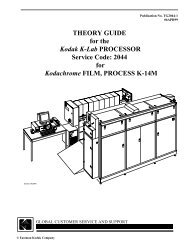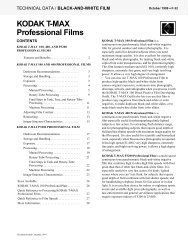Using KODAK EKTACOLOR PRIME SP Chemicals in DKS ... - 125px
Using KODAK EKTACOLOR PRIME SP Chemicals in DKS ... - 125px
Using KODAK EKTACOLOR PRIME SP Chemicals in DKS ... - 125px
Create successful ePaper yourself
Turn your PDF publications into a flip-book with our unique Google optimized e-Paper software.
Replenishment Rates<br />
The replenishment rates <strong>in</strong> Table 2 are start<strong>in</strong>g-po<strong>in</strong>t<br />
recommendations. The actual rates will depend on<br />
specific process<strong>in</strong>g conditions such as the amount of<br />
paper processed and the proportion of high- or lowdensity<br />
pr<strong>in</strong>ts.<br />
The bleach-fix replenishment rates assume typical<br />
developer carryover and processor utilization. It also<br />
allows a safety factor for periods of low utilization, tank<br />
top off, etc. If carryover is greater than normal, <strong>in</strong>crease<br />
the bleach-fix replenishment rate to ma<strong>in</strong>ta<strong>in</strong> the bleachfix<br />
chemical balance and pH level. Otherwise, problems<br />
such as reta<strong>in</strong>ed silver may occur. Reta<strong>in</strong>ed silver will<br />
cause pr<strong>in</strong>t colors to look desaturated. A lower rate may<br />
be acceptable if carryover is m<strong>in</strong>imal. A bleach-fix<br />
replenisher rate of 54 mL/m2 has been found acceptable<br />
<strong>in</strong> a typical well-ma<strong>in</strong>ta<strong>in</strong>ed mach<strong>in</strong>e. See the equipment<br />
manual for specifications and adjustments for squeegees<br />
or squeegee rollers.<br />
Agitation<br />
Good agitation is important dur<strong>in</strong>g the first few seconds<br />
of the developer and bleach-fix steps. If <strong>in</strong>itial agitation is<br />
poor <strong>in</strong> the developer, development may be uneven. Poor<br />
<strong>in</strong>itial agitation <strong>in</strong> the bleach-fix may not stop<br />
development uniformly, which can cause magenta streaks<br />
and non-uniformity.<br />
Filtration<br />
Process<strong>in</strong>g solutions and wash water may conta<strong>in</strong><br />
<strong>in</strong>soluble materials. If you don’t filter out these materials,<br />
they may stick to the paper, tank walls, rollers, and l<strong>in</strong>es,<br />
and can damage the paper. It is also important to replace<br />
solution filters periodically so that a blocked filter does<br />
not reduce solution flow. Use the filters designed for the<br />
processor and recommended <strong>in</strong> the equipment manual.<br />
Dry<strong>in</strong>g<br />
The maximum dry<strong>in</strong>g temperature for <strong>KODAK</strong> EDGE<br />
and ROYAL Digital Color Papers is 96°C (205°F).<br />
Low Utilization<br />
The number of pr<strong>in</strong>ts that you produce each week<br />
determ<strong>in</strong>es the processor utilization. If your processor<br />
utilization is low, oxidation and evaporation will affect<br />
the activity of your process<strong>in</strong>g solutions and may <strong>in</strong>crease<br />
the D-m<strong>in</strong> of the paper. Dur<strong>in</strong>g periods of low utilization,<br />
be sure to turn off the processor when it’s not <strong>in</strong> use to<br />
avoid oxidation and evaporation. In extreme cases of low<br />
utilization, you may need to discard the chemicals <strong>in</strong> the<br />
processor and replace them with fresh tank solutions. You<br />
can often reduce high D-m<strong>in</strong> <strong>in</strong> pr<strong>in</strong>ts by replac<strong>in</strong>g the<br />
stabilizer with fresh solution.<br />
SAFE HANDLING OF PHOTOGRAPHIC<br />
CHEMICALS<br />
Handle all chemicals carefully. When you mix solutions,<br />
wear goggles or a face shield, a protective apron, and<br />
protective gloves made from neoprene or nitrile rubber.<br />
Clean protective cloth<strong>in</strong>g after use to remove any<br />
chemical residue that can cause contam<strong>in</strong>ation. For more<br />
<strong>in</strong>formation about potential health hazards and safe<br />
handl<strong>in</strong>g of specific <strong>KODAK</strong> <strong>Chemicals</strong>, see the chemical<br />
labels and the Material Safety Data Sheets (MSDSs) for<br />
the chemicals. MSDSs also provide regional contact<br />
<strong>in</strong>formation. MSDSs are available on our website at<br />
www.Kodak.com/go/photochemicals<br />
<strong>Us<strong>in</strong>g</strong> <strong>KODAK</strong> <strong>EKTACOLOR</strong> <strong>PRIME</strong> <strong>SP</strong> <strong>Chemicals</strong> <strong>in</strong> <strong>DKS</strong> Digital M<strong>in</strong>ilabs with a 20-Second Cycle CIS-278E 3

















